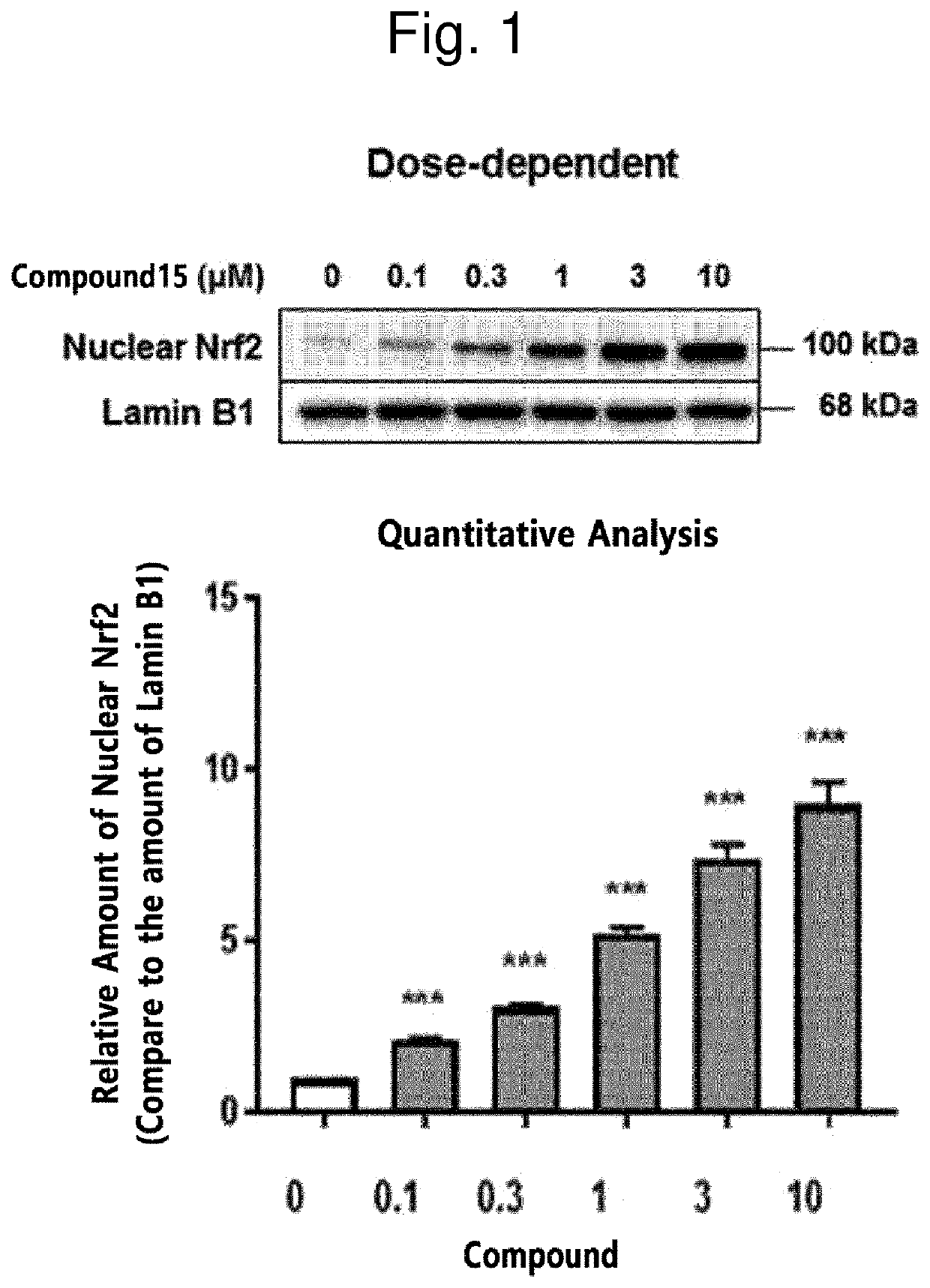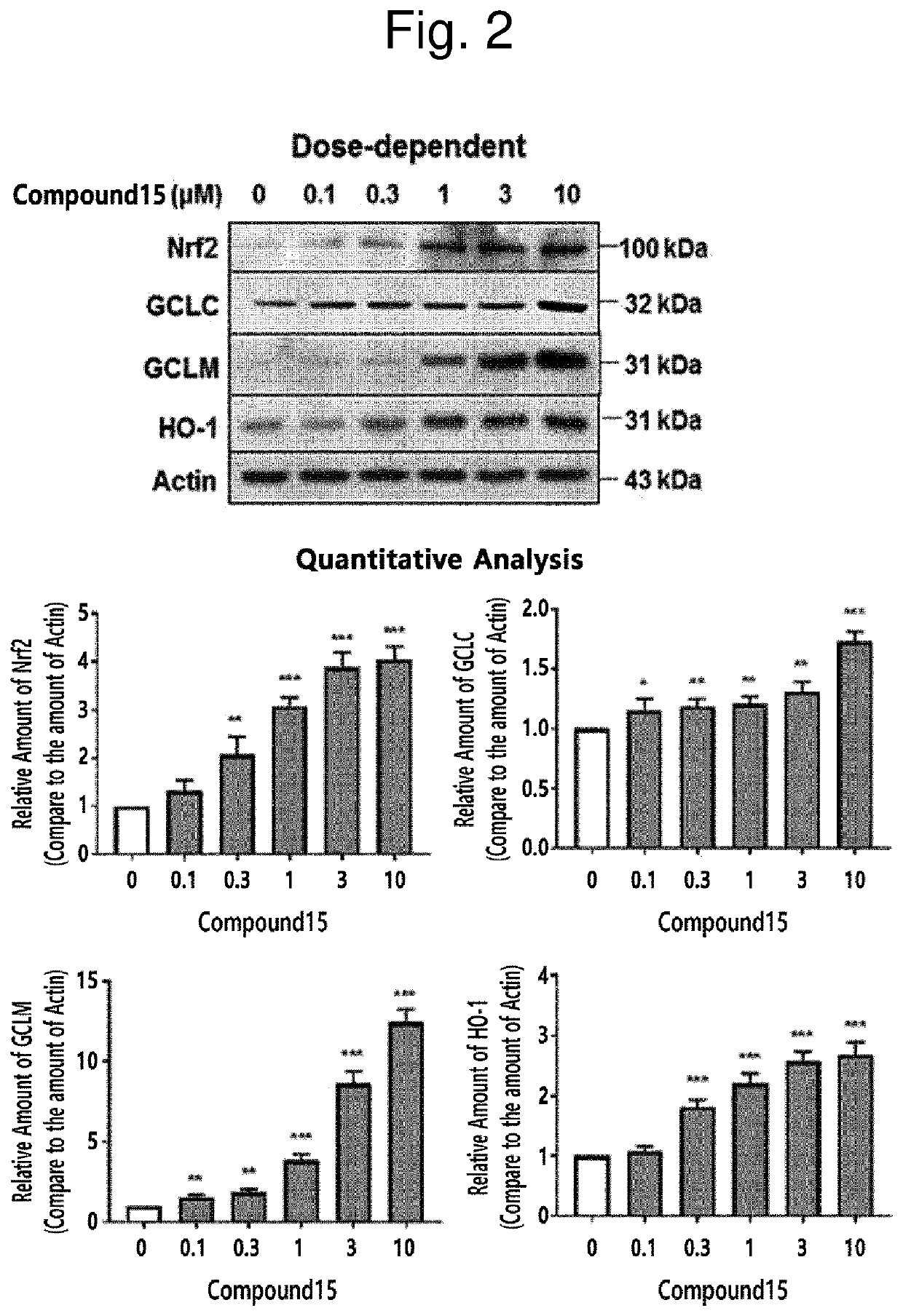Novel halo-(3-(phenylsulfonyl)prop-1-enyl)pyridine derivative and use thereof
a phenylsulfonyl and pyridine technology, applied in the direction of heterocyclic compound active ingredients, group 5/15 element organic compounds, etc., can solve the problems of low bioavailability and drug metabolic stability of vsc2, low bioavailability of vsc2, and ineffective use, and achieve the effect of reducing the activity of nrf2
- Summary
- Abstract
- Description
- Claims
- Application Information
AI Technical Summary
Benefits of technology
Problems solved by technology
Method used
Image
Examples
preparation example 1
(hydroxyphenylsulfonyl)methylphosphonate
Step 1-1: Synthesis of (diethoxyphosphoryl)methyl 4-methylbenzenesulfonate from diethyl hydroxymethylphosphonate
[0097]
[0098](Diethoxyphosphoryl)methyl 4-methylbenzenesulfonate was synthesized according to the reaction scheme above. Specifically, diethyl hydroxymethylphosphonate (10 g, 0.06 mol) was dissolved in methylene chloride (MC), and triethylamine (9.80 mL, 0.07 mmol) and 4-toluenesulfonyl chloride (13.3 g, 0.07 mol) were sequentially added thereto and stirred at room temperature for 3.5 hours. After the reaction was completed, the reaction solution was diluted with ethyl acetate (EtOAc) and washed with water and brine, and then the organic layer was dried over anhydrous Na2SO4 and filtered. The residue obtained by distilling the solvent under reduced pressure was purified by column chromatography (ethyl acetate:n-hexane=1:3) to obtain (diethoxyphosphoryl)methyl 4-methylbenzenesulfonate (10 g) in a yield of 52%.
[0099]Yellow oil;
[0100]Rf=...
example 1
of (E)-3-fluoro-2-(2-(2-fluorophenylsulfonyl)vinyl)pyridine (Compound 1)
[0189]
[0190]After dissolving diethyl (2-fluorophenylsulfonyl)methylphosphonate (1-3a, 1 eq) prepared according to Preparation Example 1 in anhydrous THF (0.1 M), the reaction mixture was cooled to −78° C. using dry ice and acetone. n-BuLi (1.2 eq, 2.0 M cyclohexane solution) was slowly added dropwise to the solution and stirred for 1 hour, and then 3-fluoropicolinaldehyde (1.2 eq) was added and reacted again for another hour. If the reaction had not completed when confirmed by TLC, the reaction was carried out for another 30 minutes at room temperature. After the reaction was terminated with a small amount of water, the reaction mixture was extracted with water and 10% MeOH / MC, a small amount of water was removed from the organic layer using anhydrous Na2SO4, and the solvent was removed by distillation under reduced pressure and vacuum-dried. Thereafter, the products were separated and purified by column chromat...
example 2
of (E)-3-fluoro-2-(2-(3-fluorophenylsulfonyl)vinyl)pyridine (Compound 2)
[0195]The reaction was performed in the same manner as in Example 1 to obtain (E)-3-fluoro-2-(2-(3-fluorophenylsulfonyl)vinyl)pyridine, except that diethyl (3-fluorophenylsulfonyl)methylphosphonate (1-3b) was used instead of diethyl (2-fluorophenylsulfonyl)methylphosphonate (1-3a).
[0196]Yield: 62%;
[0197]Rf=0.41 (hexane:EtOAc=1:1);
[0198]1H NMR (300 MHz, DMSO): δ 7.60-7.93 (m, 8H, 2 trans H), 8.52-8.54 (m, 1H);
[0199]13C NMR (75 MHz, DMSO): δ 114.7 (d, JC-F=24.4 Hz), 121.2 (d, JC-F 21.1 Hz), 123.8 (d, JC-F=3.0 Hz), 124.8 (d, JC-F=18.8 Hz), 128.0 (d, JC-F=4.7 Hz), 132.1 (d, JC-F=13.5 Hz), 132.1, 133.7, 138.4 (d, JC-F=10.9 Hz), 141.7 (d, JC-F 6.7 Hz), 146.3 (d, JC-F=4.8 Hz), 158.3 (d, JC-F=288.2 Hz), 161.7 (d, JC-F=273.9 Hz).
PUM
| Property | Measurement | Unit |
|---|---|---|
| Temperature | aaaaa | aaaaa |
| Temperature | aaaaa | aaaaa |
| Temperature | aaaaa | aaaaa |
Abstract
Description
Claims
Application Information
 Login to View More
Login to View More - R&D
- Intellectual Property
- Life Sciences
- Materials
- Tech Scout
- Unparalleled Data Quality
- Higher Quality Content
- 60% Fewer Hallucinations
Browse by: Latest US Patents, China's latest patents, Technical Efficacy Thesaurus, Application Domain, Technology Topic, Popular Technical Reports.
© 2025 PatSnap. All rights reserved.Legal|Privacy policy|Modern Slavery Act Transparency Statement|Sitemap|About US| Contact US: help@patsnap.com



